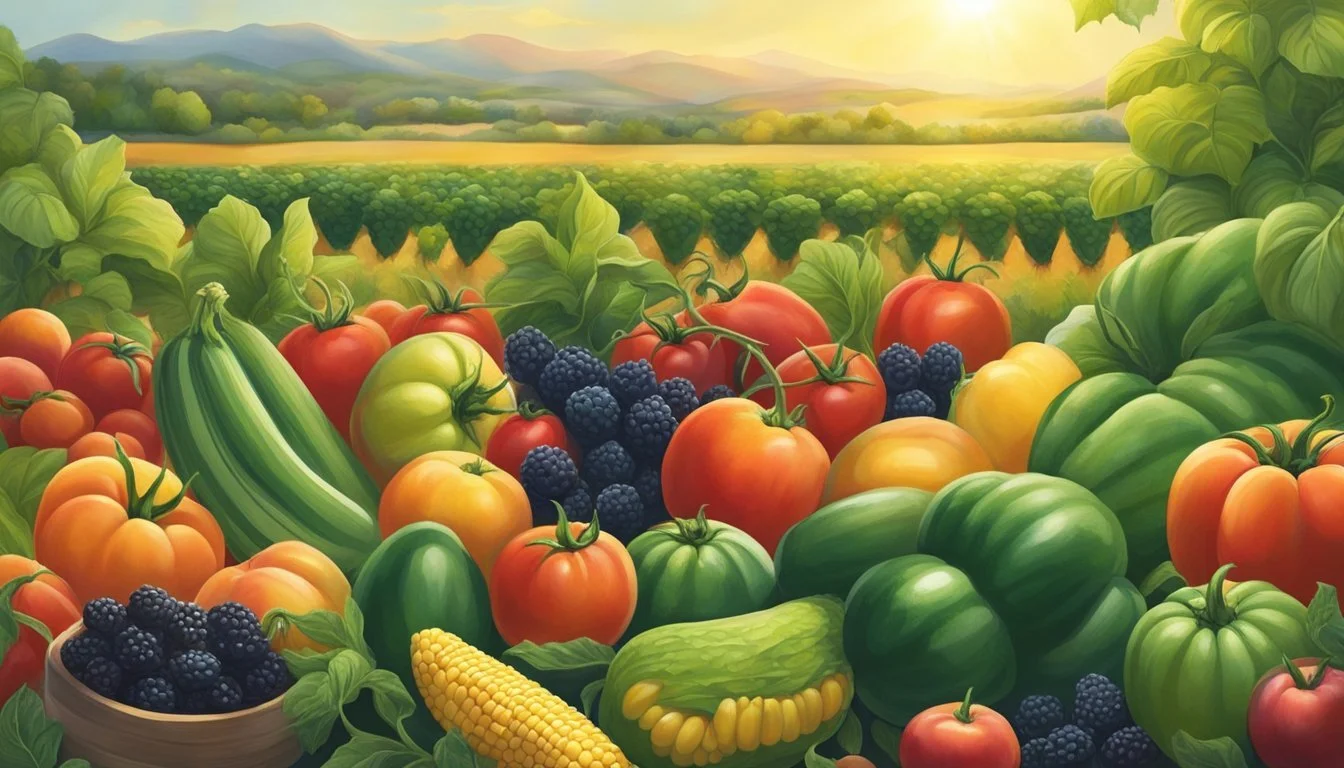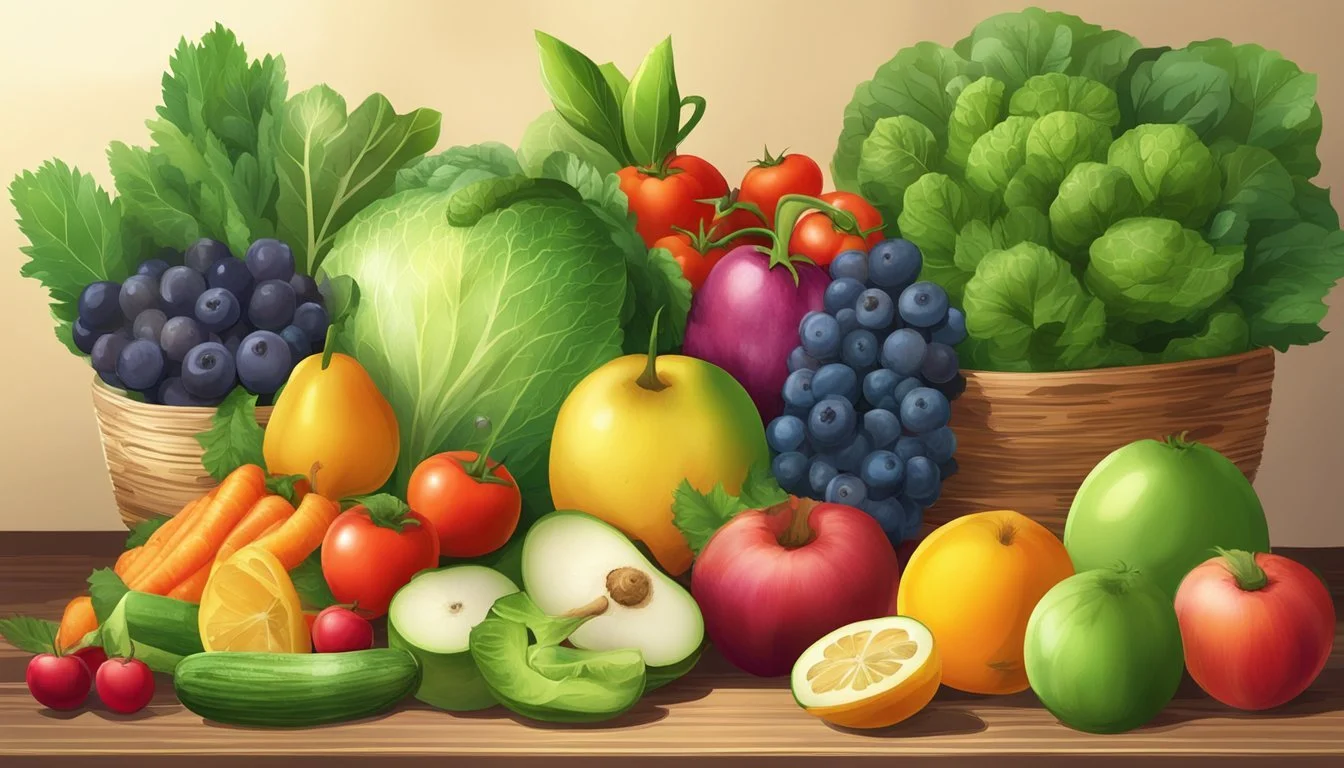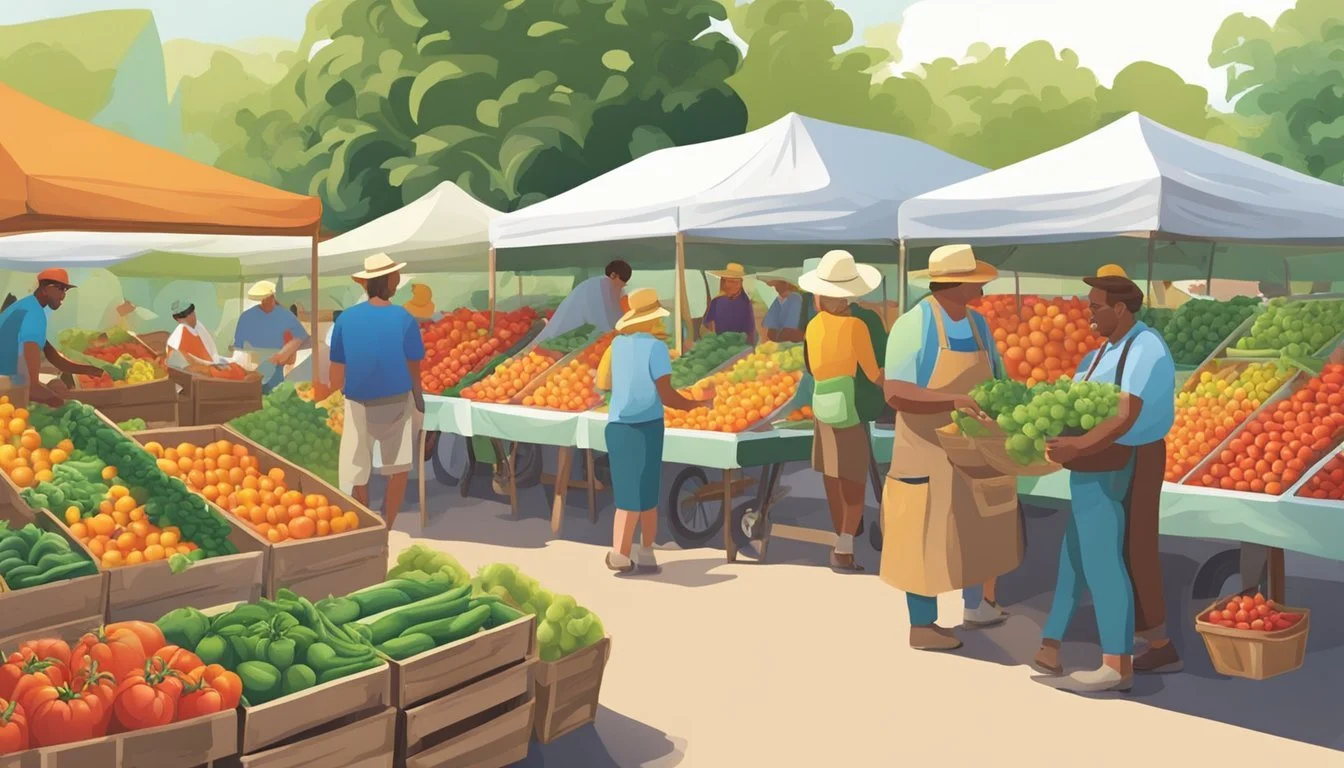Arkansas Seasonal Fruit & Vegetables in July
A Guide to Local Produce
This Article is Part of our Arkansas Seasonal Fruit & Veg Calendar
July in Arkansas heralds the peak of summer, a vibrant season for the state's agriculture. During this month, farmers' markets and roadside stands overflow with the freshest local produce, a clear reflection of the state's fertile lands and favorable growing conditions. The state's climate, characterized by hot, sunny days followed by cooler nights, creates an ideal environment for a variety of fruits and vegetables to thrive.
Among the bounty, July offers a rich assortment of fruits in Arkansas. Peaches, a beloved summer staple, reach their juicy zenith. Blueberries (how long do blueberries last?) and blackberries (how long do blackberries last?), bursting with flavor, are also ripe for the picking. These fruits not only contribute to Arkansas's agricultural economy but also to the nutritional and culinary enjoyment of its residents and visitors alike.
The vegetable selection is equally robust, with produce like okra, cucumbers (how long do cucumbers last?), and green beans becoming readily available. These vegetables are essentials for the Southern table, often featured in home-cooked meals and traditional recipes passed down through generations. Arkansas's July bounty is the heart of the state's summer cuisine, offering freshness and quality that supermarket imports often can't match.
Seasonal Overview
July marks the peak of summer in Arkansas, a time when a diverse array of fresh fruits and vegetables reach their optimal ripeness. This season not only offers a palette of flavors but also nutrient-rich produce that supports local economies and dietary health.
Summer Seasonality in Arkansas
Fruits:
Peaches: Reach their juicy prime
Watermelons and Cantaloupes (how long does cantaloupe last?): Become widely available
Berries: Blackberries and blueberries are ripe for picking
Vegetables:
Tomatoes: Flourish in the warmth, offering a variety of types
Green Beans: Are tender and plentiful
Sweet Corn: Is at its sweetest, perfect for summer barbecues
Importance of Eating In Season
Nutritional Value: Seasonal produce is often at its nutritional peak, offering a higher content of vitamins and antioxidants.
Flavor and Freshness: Fruits and vegetables in season tend to be fresher, tastier, and perfectly ripe, having been harvested at the correct time for optimal taste.
Supporting Local: Buying seasonal produce supports Arkansas farmers and the local economy, fostering community ties and sustainability.
By enjoying the seasonal offerings, one not only indulges in the best flavors but also contributes to a healthier lifestyle and a stronger local community.
Fruits in Season
July in Arkansas ushers in a bounty of fresh, ripe fruits perfect for summer eating. Home gardens and local markets brim with colorful selections, from sweet, plump berries to juicy melons.
Berries
Arkansas's climate in July is ideal for berry cultivation, yielding fruits that are rich in flavor and nutrients.
Blackberries: These berries are at their peak, with their deep purple-black hue signaling readiness for harvest.
Blueberries: A staple of the summer, they're plentiful now, perfect for fresh salads or homemade pies.
Raspberries: More delicate than their berry cousins, raspberries offer a subtly sweet taste that is best when picked fresh.
Stone Fruits
Stone fruits, so named for their central "stone" or pit, are particularly succulent during the warm July days.
Peaches: They are at their juiciest now. Arkansas peaches are known for their soft, fragrant flesh.
Nectarines: Similar to peaches but with smooth skin, they add a burst of sweetness to any summer dessert or snack.
Melons
The warmth of the Arkansas summer sun helps produce melons that are refreshingly sweet and hydrating.
Watermelon: Synonymous with summer, these large, green-striped melons contain bright red, sweet flesh interspersed with black seeds.
Cantaloupe: Also in season, with a netted rind and sweet, orange flesh, these melons are rich in flavor and perfect for a refreshing treat.
Vegetables in Season
In July, Arkansas gardens are abundant with a variety of vegetables. Shoppers and gardeners can expect peak freshness and flavor from a selection of leafy greens, hearty root vegetables, and succulent summer squashes.
Leafy Greens
Leafy greens, including various types of lettuce and spinach, thrive in the mild early summer climate of Arkansas. They are usually harvested before the heat of midsummer hits, ensuring tender, flavorful leaves.
Lettuce: Includes varieties such as romaine, butterhead, and leaf lettuces.
Spinach: Best when harvested young for optimal taste and texture.
Root Vegetables
Root vegetables are at their best in July, with beets and radishes being particularly noteworthy for their vibrant colors and crisp texture. These vegetables store well and can be used in a variety of dishes.
Beets: Deep red and rich in flavor, perfect for salads or roasting.
Radishes: They offer a peppery kick and crunch, ideal for fresh salads or garnishes.
Summer Squashes
As the name suggests, summer squashes are in their prime during this month. Two of the most popular varieties available in Arkansas are zucchini and yellow squash. These vegetables are versatile in cooking, used in dishes from stir-fries to grilling.
Zucchini: A staple in summer dishes, can be eaten raw or cooked.
Yellow Squash: Mild in flavor, works well when sautéed or baked.
Additional summer vegetables available in Arkansas include:
Cabbage: Known for its layered, crunchy leaves.
Cucumbers: Refreshing and crisp, perfect for salads.
Okra: Often used in stews and frying, recognized by its ridged pods.
Arkansas Specialty Produce
Arkansas supports a variety of specialty produce, with July bringing a prime time for certain herbs and nut crops. The state's warm climate and fertile soil contribute to the growth of high-quality, flavorful specialty items that are sought after both locally and beyond.
Herbs
In July, Arkansas's herb gardens are full of life, offering a range of fresh flavors. Commonly cultivated herbs during this month include:
Basil: An aromatic staple in culinary uses, thriving in the summer heat.
Mint: Known for its refreshing taste, ideal for cool summer beverages.
Rosemary: Characterized by its needle-like leaves and woody aroma, this herb is often used in grilling.
Nut Crops
Nut trees in Arkansas begin to hint at the forthcoming harvest in July, though many nuts will not be fully mature until later in the year. However, nut trees are an important part of Arkansas's agricultural landscape, and include:
Pecans (how long do pecans last?): Arkansas's state nut, pecan trees are widespread and begin to form their nuts in July.
Harvesting Tips
When harvesting fruits and vegetables in Arkansas during July, one should be diligent in assessing ripeness for the freshest produce. For fruits like peaches, which peak in this month, a gentle twist from the stem should be enough if they are ripe. The fruit should detach easily if it's ready to be picked.
Leafy Greens: For kale and collards, one should harvest the outer leaves first, leaving the inner ones to continue growing. The leaves should be vibrant and firm. Spinach leaves are best when they are bright green and tender; they usually have a more flavorful punch when young.
Root Vegetables: Vegetables such as turnips and radishes should be pulled from the soil gently to avoid damaging the produce. Their root should be firm and the skin smooth.
Produce Type Harvesting Sign Peach Yields to gentle pressure Kale Firm outer leaves Spinach Bright green, tender leaves Turnips Firm root Radishes Smooth skin
One should always use the proper container when harvesting; it should be sturdy but gentle enough to prevent bruising the produce. A basket or a netted bag allows for air circulation which keeps the harvested items fresher longer.
For the best quality, harvest either in the early morning or in the cool of the evening to avoid the heat of the day which can stress the plants and reduce the quality of your freshly picked fruits and vegetables. After picking, it's advisable to store the produce in a cool place as soon as possible to maintain its freshness.
Storage and Preservation
Proper storage and preservation are crucial for maintaining the freshness and nutritional value of fruits and vegetables in July. Here are specific methods for short-term storage and preserving through freezing and canning.
Short-Term Storage
For immediate consumption or use within a few days, most vegetables can be stored in the fridge to stay crisp. Leafy greens should be wrapped in paper towels and placed in a plastic bag to retain moisture yet prevent wilting. Root vegetables like potatoes and onions are best kept in a cool, dark, and well-ventilated location; they should not be refrigerated but can be kept on the counter if the area is not too warm or exposed to sunlight, which can cause them to sprout or become shriveled.
Fridge:
Leafy greens: Kale, spinach (in plastic bags with paper towels)
Berries: Rinse and store in ventilated containers
Counter:
Root vegetables: Potatoes, onions (in a cool, dark place)
Tomatoes: Ripen on the counter, refrigerate if necessary to extend freshness
Freezing & Canning
For long-term preservation, freezing and canning are effective methods. Berries can be frozen by first spreading them on a baking sheet to freeze individually to prevent clumping and then transferring them to air-tight containers or freezer bags. Vegetables like squash and green beans should be blanched prior to freezing to halt enzyme activity that causes loss of flavor, color, and texture.
Canning offers a way to save the bounty of July fruits and vegetables. Tomatoes and peaches can be canned using a water bath, while vegetables like green beans require pressure canning due to their low acidity.
Freezing:
Berries: Spread on baking sheet, then store in freezer bags
Vegetables: Blanch, then freeze in air-tight containers
Canning:
Tomatoes, Peaches: Water bath canning
Green Beans: Pressure canning
Preparation and Usage
In Arkansas, July brings a bounty of fresh fruits and vegetables ripe for culinary use. Chefs and home cooks alike can enjoy the vibrant flavors of the local harvest by incorporating these seasonal ingredients into a variety of dishes, from refreshing salads and sides to hearty main courses and delectable desserts.
Salads and Sides
Arkansas' July produce lends itself beautifully to salads and side dishes. One might combine sliced cucumbers, ripe tomatoes, and sweet bell peppers to create a vibrant summer salad. Accentuated with a simple vinaigrette, these ingredients fuse into a dish that celebrates the season's freshness. For a heartier side, they could roast okra with a dash of olive oil and sea salt (how long does sea salt last?) until it achieves a delightful crispiness.
Sample Summer Salad:
Cucumbers (sliced)
Tomatoes (quartered)
Bell peppers (julienned)
Red onion (thinly sliced)
Dressing:
Olive oil
Vinegar
Salt and pepper
Roasted Okra:
Okra pods
Olive oil
Sea salt
Bake at 425°F for 20-25 minutes
Main Dishes
One might utilize plump eggplants (What wine goes well with eggplant?) and summer squash as the foundation for savory main dishes. An eggplant parmesan, where slices of eggplant are breaded and fried, then layered with marinara sauce and mozzarella cheese, utilizes the rich flavors of local Arkansas produce. Summer squash can be sautéed with herbs and onions for a simple yet flavorful accompaniment to grilled chicken or fish.
Eggplant Parmesan:
Eggplants (sliced and breaded)
Marinara sauce
Mozzarella cheese
Bake until golden and bubbling
Sautéed Summer Squash:
Summer squash (sliced)
Onions (diced)
Herbs (thyme, basil)
Sauté until tender
Sweets and Compotes
July's sweetness can be captured in desserts and compotes. One could create a compote by simmering peaches and blackberries with a touch of sugar and lemon, ideal for topping ice cream or yogurt. Arkansas blueberries and raspberries shine in tarts and pies, with their natural sweetness intensified through baking.
Peach and Blackberry Compote:
Peaches (sliced)
Blackberries
Sugar (to taste)
Lemon juice
Simmer until fruits are soft and syrupy
Berry Tart:
Blueberries and raspberries
Tart crust (pre-baked)
Custard filling
Arrange berries atop custard and chill before serving
Supporting Local Agriculture
When July rolls around in Arkansas, the local agriculture sector is at one of its peak production times. The Arkansas Vegetable Planting Calendar indicates an abundance of fresh produce is available to consumers.
Benefits of Local Produce
Local produce, harvested at the peak of ripeness, is known for its superior flavor and nutritional value. For instance, Arkansas' rich soil and climate conditions in July contribute to the harvest of vibrant vegetables like tomatoes, sweet corn, and okra. Consumers benefit from this fresh produce as nutrients are often higher when fruits and vegetables are allowed to ripen naturally on the plant and consumed shortly after harvest. Moreover, purchasing local produce supports the state's farmers and economy and reduces the carbon footprint associated with long-distance transportation of food.
Arkansas Farmers Markets
Farmers markets across Arkansas offer a direct connection between producers and consumers. They not only serve as venues for buying fresh, local vegetables and fruits but also enhance community engagement.
Little Rock Farmers Market: Operating since 1974, it's a summer staple for fresh Arkansas produce.
Fayetteville Farmers Market: Offers a wide array of products from nearby farms, emphasizing seasonal availability.
These markets typically see a variety of vegetables from the Arkansas Vegetable Planting Calendar, including July favorites like squash, peppers, and greens. By shopping at farmers markets, consumers can ensure they are getting the freshest produce while supporting local farmers.
Resources
When seeking information regarding Arkansas seasonal fruits and vegetables in July, reliable sources are essential. The State Department of Agriculture and Local Extension Offices provide accurate calendars and guidance that help individuals stay informed about the freshest produce available.
State Department of Agriculture
The Arkansas Department of Agriculture is a valuable resource for discovering what fruits and vegetables are in season. Their website typically offers a comprehensive Local Harvest Calendar with monthly views of available produce. This calendar is a key tool for consumers looking to buy seasonally and support local agriculture. It includes details about when specific produce items, such as peaches, watermelons, and tomatoes, are at their peak in July.
Local Extension Office
Local Extension Offices provide community-focused resources, including seasonal produce guides and educational material. The offices have experts who can offer personalized advice and information on local agricultural practices. They often host blogs or articles about seasonal food, detailing not only what is available but also providing suggestions on how to prepare and store these fresh items. Extension offices serve as a bridge between the Department of Agriculture and the local community, ensuring the dissemination of accurate and useful farming information.










